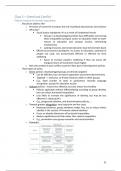Class 5 – Greed and Conflict
Policies towards horizontal inequali,es
- Should we address HIs?
o Presence of severe HIs increases the risk of poli,cal disturbances and violence
o Why else?
§ Social jus,ce standpoint: HI as a result of funda,onal shocks
• Groups in a disadvantaged posi,on have difficul,es overcoming
those inequali,es (unequal access to educa,on leads to lower
returns to educa,on and unequal income, interlocking
mechanisms)
• Lacking resources and certain dynamics have to be broken down
§ Efficiency (economic) standpoint: no access to educa,on, poten,al of
people not used, not economically efficient or efficient for their
wellbeing
• Easier to increase people's wellbeing if they are worse off,
marginal return of investment much higher
o Not only needed in post-conflict countries! Also part of development policies
- Three types of policy
o Direct policies: disadvantaged groups are directly targeted.
§ Can be effec,ve, but can lead to opposi,on and entrenched ethnicity
§ Targeted --> exclusive, so fric,on because unfair to other groups
§ E.g., fixed number of seats in parliament, minority language
recogni,on, quotas for alloca,on to jobs
o Indirect policies - may be less effec,ve, but also arouse less hos,lity
§ Policies applicable without differen,a,ng according to group iden,ty,
but can reduce horizontal inequali,es
§ Less likely to increase the significance of iden,ty, but may be less
effec,ve in reducing HI’s
§ E.g., progressive taxa,on, an,-discrimina,on policies, …
o Towards greater integra,on: very long term and has costs
§ Reducing resilience, group iden,,es maaer less, try to reduce ethnic
iden,ty in the society à Promote na,onal iden,ty!
§ Focus on iden,ty dimension of horizontal inequali,es
§ Reduce significance but hide rather than reduce inequali,es
§ E.g., promo,on cross-group economic and social ac,vi,es
o Examples:
21
, o HIs mostly neglected in interna,onal policy
§ Aid oCen worsens HI (e.g., Burundi): money not spent according to its
purpose
§ 'Structural adjustment'/pro-market policies also oCen lead to a
worsening of HI
• If you let a market go naturally, it will not get rid of HI but the
opposite
§ Ignored in most PRSPs (Poverty Reduc,on Strategy Papers)
§ Also neglected in much poli,cal condi,onality - towards elec,ons and
mul,party democracy
• Free and fair elec,on does not ensure equal representa,on
§ But (implicitly) par,ally included in 'Human Rights Approach' and Social
Exclusion approach
• Even though the elite can be elected democra,cally, will be bad
for the people
§ More aaen,on for group inequali,es since introduc,on of SDGs
§ HI oCen not systema,cally and comprehensively addressed in countries
coming out of conflict
- Horizontal inequali,es and post-conflict development
o To what extent are post-conflict countries trying to address HI and to what
effect?
o 7 case studies: Burundi, Afghanistan, Rwanada, Nepal, Peru, Guatemala, Bosnia
and Uganda
o 4 thema,c chapters: macro-economic policies, PRSPs, priva,za,on and
employment genera,on
§ Ques,ons: are they recognized? Was there a rhetoric recogni,on
translated in policy? Did they actually have an impact?
• Have post-conflict countries recognized the role of HI’s and have
they made any commitments of addressing it?
§ Implementa,on: has the recogni,on been translated into the policy
and have they implemented the policy?
§ Effec,veness: have these policies been effec,ve or had an impact?
Some,mes has the opposite effect
§ Readers
- Ques,ons for reflec,on
o To what extent have HI been addressed in the post-conflict era in your case
studies?
22




